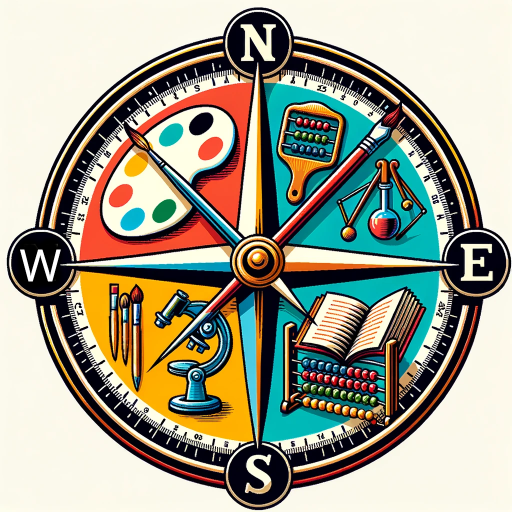Curriculum Design-AI-powered curriculum planning
AI-Powered Curriculum Design for Educators
Design a curriculum for a high school environmental science course for one semester.
I need a two-year curriculum outline for ancient civilizations for undergraduates.
What teaching methods and assessments would you recommend for a Grade 9 math course?
List essential resources for a semester-long course in creative writing for Grade 12.
Related Tools
Load More
Instructional Design and Technology Expert
The #1 instructional design tool. A master of modern instructional design and technology. Custom RAG pipeline.

Course Maker
Create a to learn any skill, topic, subject, etc. Includes Projects Ideas & Structured Layouts.

Curriculum Compass
Align with Standards and Craft Comprehensive, Multimedia-Enriched Lessons and Plans for K-12 Education, Home School or your other Educational Needs.

Learning Objective Writer for Instructional Design
I'll help you write measurable, meaningful learning objectives so that you can design better learning.

Curriculum Crafter
Designer of diverse educational courses and materials.

Course Design Wizard
Helping professors and other university/college educators create better assignments, rubrics, and course syllabus policies in the AI era, designed by the team behind the AutomatED newsletter.
20.0 / 5 (200 votes)
Introduction to Curriculum Design
Curriculum Design is the process of planning and organizing the content, structure, and delivery methods of an educational program. This involves setting learning objectives, selecting appropriate instructional materials, and determining the best methods for assessing student learning. The purpose of curriculum design is to create a coherent and effective educational experience that meets the needs of learners and aligns with educational standards and goals. For example, a curriculum designed for a high school biology course would include detailed plans for topics like cell biology, genetics, and ecology, along with lab activities, quizzes, and projects to reinforce learning.

Main Functions of Curriculum Design
Setting Learning Objectives
Example
Defining what students should know and be able to do by the end of a course or program.
Scenario
In a Grade 9 history class, learning objectives might include understanding major historical events and their impacts, developing critical thinking skills, and being able to analyze primary and secondary sources.
Organizing Content and Structure
Example
Sequencing topics and units logically to build on prior knowledge and facilitate learning progression.
Scenario
For an undergraduate course in Environmental Science, the curriculum might start with foundational concepts in ecology, followed by units on human impacts on the environment, conservation strategies, and sustainable development.
Selecting Instructional Methods
Example
Choosing appropriate teaching methods and activities that engage students and enhance learning.
Scenario
In a middle school math class, a combination of direct instruction, group problem-solving activities, and hands-on manipulatives might be used to teach concepts like fractions and geometry.
Ideal Users of Curriculum Design Services
Educators and Teachers
Educators and teachers benefit from curriculum design services by receiving well-structured plans that support effective teaching and learning. These services help them align their instruction with educational standards, incorporate best practices in pedagogy, and provide diverse learning activities to meet the needs of all students.
Educational Administrators and Curriculum Developers
Educational administrators and curriculum developers use curriculum design services to ensure that the educational programs offered by their institutions are coherent, comprehensive, and aligned with strategic goals. They rely on these services to develop curricula that meet accreditation requirements, address the needs of their student populations, and incorporate emerging trends and technologies in education.

Guidelines for Using Curriculum Design
1
Visit aichatonline.org for a free trial without login, no need for ChatGPT Plus.
2
Specify the subject area, grade level, and duration for your curriculum.
3
Provide core objectives, topics, and any specific requirements for the curriculum.
4
Review the generated curriculum, making any necessary adjustments to fit your educational needs.
5
Implement the curriculum in your teaching environment, using recommended methods and resources.
Try other advanced and practical GPTs
Protocolo P - 02
AI-powered tool for scientific writing

Protocolo - 03
AI-Powered Scientific Writing Simplified

Protocolo P - 01
AI-powered tool for precise writing

LightCalc
AI-powered lighting recommendations.

CodePure
AI-powered code solutions at your fingertips

恋愛占い×ショート動画生成
AI-powered love fortune scripts for TikTok

ベテランリライター(脚本)
Transform your text with AI precision.

PHP
AI-Powered PHP Development Assistance

Research Buddy
Unlock the Power of AI for In-Depth Research.

⭐️ Cocoa Twins® Trendy Undercut Prompt Pro ⭐️
AI-powered custom art for trendsetters.

Odoo Dev Expert
Your AI-powered Odoo development guide

Physics Solver Pro
AI-Powered Physics Problem Solver

- Curriculum Planning
- Lesson Design
- Teaching Resources
- Educational Strategies
- Assessment Methods
Common Questions about Curriculum Design
What is the main purpose of Curriculum Design?
Curriculum Design helps educators create structured, comprehensive learning plans tailored to specific subjects, grade levels, and durations.
How customizable is the curriculum generated by this tool?
The curriculum is highly customizable, allowing users to adjust core objectives, topics, teaching methods, and assessment strategies to fit their unique needs.
Can Curriculum Design be used for all educational levels?
Yes, Curriculum Design is versatile and can be used for any educational level, from elementary to higher education.
What types of teaching methods are recommended?
The tool suggests various pedagogical techniques, including interactive discussions, field trips, group projects, and more, depending on the subject and grade level.
Are there any additional resources or materials required?
The tool provides a list of essential textbooks, software, and other resources necessary for the course, ensuring educators have everything they need to implement the curriculum effectively.